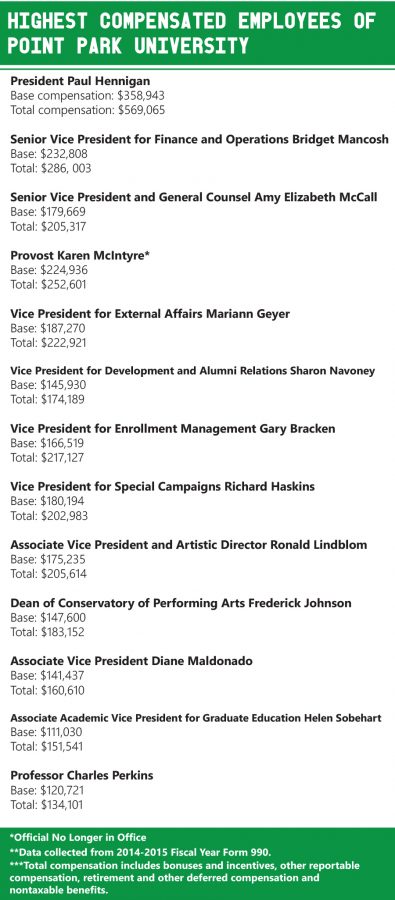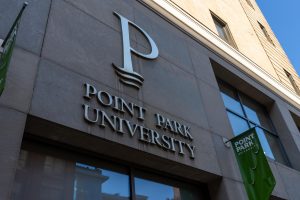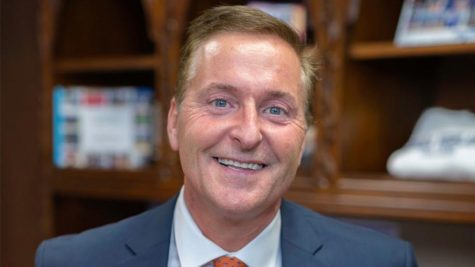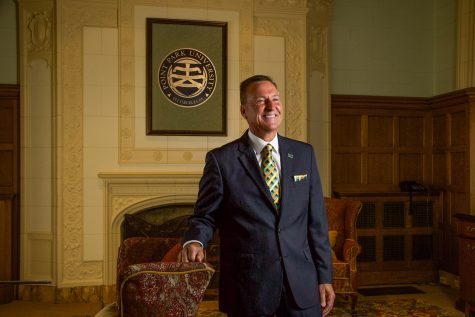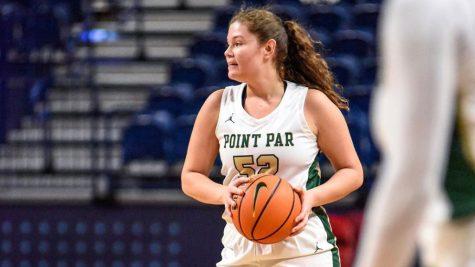IRS form shows administration saw raises amidst freezes in full-time faculty pay
December 6, 2016
Despite longtime salary freezes to faculty members, Point Park’s president and top administrators have received consistent raises to their base compensation pay, other means of compensation and nontaxable benefits for at least three straight years.
Top in salary is Point Park President Paul Hennigan, who tax records say earned $358,943 in base compensation, followed by Senior Vice President of Finance and Operations Bridget Mancosh at $232,808 and former Provost Karen McIntyre at $224,936.
According to the university’s Form 990, financial information required by the IRS from nonprofit organizations, the administration’s pay increases have paralleled significant revenue gains by the university.
The pay increases come in the midst of negotiating sessions with the adjunct faculty union, which ended with a contract last November, and the full-time faculty union. The bargaining discussions for the full-time faculty union contract are currently ongoing.
President Hennigan’s base compensation in the 2014-15 fiscal year – the last year information was available – was an increase of approximately 4.3 percent from his 2012-13 salary.
However, in that same time period, Hennigan’s total compensation that includes a wide assortment of benefits rose at a more pronounced rate. The total compensation calculates bonus and incentive compensation, retirement and deferred compensation, other reportable compensation and nontaxable benefits.
Included in Hennigan’s total compensation numbers is a paid monthly housing allowance, which is reported as taxable income. It is stated on the Form 990 that the allowance is “in place of staying in a house on campus, the standard for colleges and universities.”
The university reported that “the only personal services for Paul Hennigan provided by the university is dependent care services for his children.” Additionally, travel expenses for Hennigan’s wife are reimbursable for “official business,” as per his employment contract.
This total line of compensation numbers for Hennigan came out to $569,065 in the 2014-15 fiscal year. This represents a 1.25 percent-increase from the president’s total compensation of $561,920 in 2013-14. Hennigan, who has served as the university’s president for ten years, received a total compensation of $521,622 in the 2012-13 fiscal year.

Point Park also pays for dues for Hennigan and Mariann Geyer, vice president of external affairs, for memberships to business clubs that the university has “identified… as having members yielding significant impact on fundraising and the university’s role in the downtown community.”
The university’s second-highest paid official in the 2014-15 fiscal year was Mancosh, who was paid $232,808 in base compensation with a total compensation figure of $286,003. These numbers represent increases of 10.8 percent and 1.6 percent, respectively.
Point Park’s former Provost Karen McIntyre, Vice President for External Affairs Mariann Geyer and former Vice President for Development and Alumni Relations Richard Haskins were the only university management officials named in the Form 990 to see a decrease in their total compensation in 2014-15.
The Point Park president’s office declined to comment on questions regarding the administration’s pay sent via email, stating that it is the university’s policy to not comment on information on individual employees.
Across the board, the university’s management has enjoyed increases to their base compensation pay from the 2012-13 fiscal year to the 2014-15 fiscal year, the last report available to the public.
The seven Point Park administration officials named in all three reports from the 2012-13 to the 2014-15 fiscal year enjoyed a cumulative base compensation pay raise of just over 8 percent.
In that same time period, the university’s faculty members allege that they received almost no pay increases.
Joseph J. Pass, an attorney at Jubelirer, Pass & Intrieri P.C., is representing Point Park’s full-time faculty members as they negotiate a union contract with the university. Pass sees a disconnect with the administration’s comparative pay raises at a time when some full-time professors are being paid “substantially less” than what he considers a living wage.
“We wish we could make some of that money,” Pass said. “The faculty hasn’t had a raise for quite some years. I hope we’re able to have the faculty receive significant increases so they’re competitive. [Hennigan’s] salary is at least as comparable and generally greater than those same comparators.”
Several separate data sets back up Pass’ claims. According to the Chronicle of Higher Education, a weekly print and online publication focused on academic affairs, the faculty at Point Park are considerably underpaid when compared to their peers across the industry.
According to the Chronicle of Higher Education, professors at Point Park averaged $89,964 in pay in 2014. That is well below the average salary of $119,105 that other faculty made at other four-year private colleges in 2014. On average, faculty members at Point Park make more than 24 percent less than their counterparts at other institutions of higher education.
Meanwhile, administration officials at the university are earning incomes higher than the industry average. The Chronicle of Higher Education reports that management at Point Park averaged an income of $120,846 in 2014, more than 15 percent higher than the average income of management at other four-year private colleges.
Matt Pascal, president of Point Park’s Faculty Assembly, pointed to the disproportionate pay between management and faculty as one of the primary reasons that the two sides are currently sitting at the negotiating table.
“[Compensation] will be perhaps the most contentious issues in collective bargaining,” Pascal said.
Pass said that the university and faculty union have multiple negotiating sessions scheduled over the next few weeks, but also reported that the two sides haven’t discussed salary increases as of yet.
“The problem with the faculty is they haven’t had any significant raises in 12 years,” Pass said. “Now that they’re organized they have a lot of catching up to do. You have some [faculty] that need significantly more money.”
United Student Government President Blaine King was surprised to hear that the Chronicle of Higher Education reported that Point Park’s professors are paid less on average compared to their peers from other private universities.
“It shows that professors care more about their students than their pay rate,” King said. “I’ve definitely seen student-professor interaction on the rise.”
Charles Perkins was the highest paid professor on the Form 990, with a base compensation earning of $120,721 and a total compensation of $134,101.
Pascal and Pass both said they have seen the school’s financial numbers.
“There is data that backs up the argument that paying faculty a fair salary is within the budget of the university,” Pascal said.
There are many monetary figures within the school’s Form 990 that indicate the university is in good financial standing, such as increases in reported revenue and total assets held.
Point Park reported its total revenues in the 2014-15 fiscal year at $120,730,639, an increase of more than 12 percent from the previous fiscal year. Though the university additionally reported that its total expenses increased by more than 3 percent, up to $104,776,970, it still experienced a positive gain in net revenues. Point Park reported net revenues minus expenses of $15,953,669, up 73 percent from the 2013-14 fiscal year.
One of the few negative trends in the university’s 2014-15 fiscal year financial records was a loss of investment earnings. Point Park experienced three straight years of positive net gains on investment earnings from 2011 to 2014 before ending the 2014-15 fiscal year with a negative balance of $571,086.
This trend ended consecutive years of large increases in endowment gains for the University. From 2011-14, Point Park increased its net endowment gains by just over $9 million, but the school reported a gain of only $80,000 from 2013-14 to 2014-15, an increase of just 0.2 percent.
The university said in an email to The Globe that these losses followed a national trend on dried up endowment funds, a claim supported by the National Association of College and University Business Officers’ (NACUBO) annual Commonfund Study of Endowments report.
NACUBO reported that participating higher education institutions’ endowments returned an average of just 2.4 percent, down from the previous year’s returns of 15.5 percent.
Even without that growth in endowments, the university substantially grew its assets while simultaneously cutting its liabilities in 2014-15. By the end of the year, Point Park held $181,591,204 in total assets, a number up 3.8 percent from the previous year. Meanwhile, the university was able to cut its held liabilities by over $7 million, down to $70,400,04.
From the 2012-13 fiscal year to the 2014-15 fiscal year, Point Park increased its held assets by more than $18 million. In that same timespan, the university cut more than $3 million in liabilities.
According to the school’s common data sets, which are public record and available on Point Park’s website, the university only increased its number of enrolled students by 252 from the 2007-08 school year to 2015-16. During that same time period, the university’s six-year graduation rate rose from 46 percent to 58 percent, where it stands today.
The increased amount of earned revenue for the school offers one explanation for the rise in compensation for Point Park’s administration, particularly President Hennigan.
Pascal claimed he won’t “pretend to know” what the president’s incentives and bonuses are measured by, but he does offer a solution to the question regarding fair wages for faculty pay.
“The determination of one’s value to an institution should be done by looking at outcomes,” Pascal said. “For faculty, that is student learning and success, a very difficult outcome to measure, contrary to most people’s initial instincts.”



